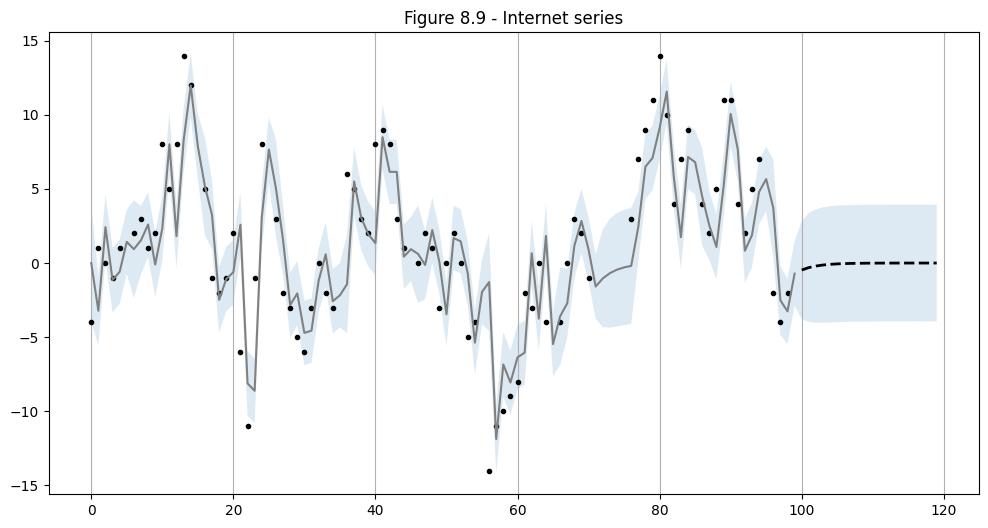SARIMAX:模型选择和缺失数据¶
该示例模仿 Durbin 和 Koopman (2012) 中第 8.4 章,将 Box-Jenkins 方法应用于拟合 ARMA 模型。新功能是模型能够处理包含缺失值的 数据集。
[1]:
%matplotlib inline
[2]:
import numpy as np
import pandas as pd
from scipy.stats import norm
import statsmodels.api as sm
import matplotlib.pyplot as plt
[3]:
import requests
from io import BytesIO
from zipfile import ZipFile
# Download the dataset
df = pd.read_table(
"https://raw.githubusercontent.com/jrnold/ssmodels-in-stan/master/StanStateSpace/data-raw/DK-data/internet.dat",
skiprows=1, header=None, sep='\s+', engine='python',
names=['internet','dinternet']
)
模型选择¶
与 Durbin 和 Koopman 一样,我们强制将一些值设置为缺失。
[4]:
# Get the basic series
dta_full = df.dinternet[1:].values
dta_miss = dta_full.copy()
# Remove datapoints
missing = np.r_[6,16,26,36,46,56,66,72,73,74,75,76,86,96]-1
dta_miss[missing] = np.nan
然后我们可以考虑使用 Akaike 信息准则 (AIC) 进行模型选择,但需要对每个变体运行模型,并选择 AIC 值最低的模型。
这里需要注意几件事:
当运行如此大量的模型时,尤其是在自回归和移动平均阶数变大时,可能会出现最大似然收敛不良的情况。由于本示例为说明性示例,我们 忽略了警告。
我们使用选项
enforce_invertibility=False,允许移动平均多项式不可逆,以便更多模型可以估计。一些模型没有产生好的结果,它们的 AIC 值被设置为 NaN。这并不奇怪,因为 Durbin 和 Koopman 指出了高阶模型的数值问题。
[5]:
import warnings
aic_full = pd.DataFrame(np.zeros((6,6), dtype=float))
aic_miss = pd.DataFrame(np.zeros((6,6), dtype=float))
warnings.simplefilter('ignore')
# Iterate over all ARMA(p,q) models with p,q in [0,6]
for p in range(6):
for q in range(6):
if p == 0 and q == 0:
continue
# Estimate the model with no missing datapoints
mod = sm.tsa.statespace.SARIMAX(dta_full, order=(p,0,q), enforce_invertibility=False)
try:
res = mod.fit(disp=False)
aic_full.iloc[p,q] = res.aic
except:
aic_full.iloc[p,q] = np.nan
# Estimate the model with missing datapoints
mod = sm.tsa.statespace.SARIMAX(dta_miss, order=(p,0,q), enforce_invertibility=False)
try:
res = mod.fit(disp=False)
aic_miss.iloc[p,q] = res.aic
except:
aic_miss.iloc[p,q] = np.nan
对于在完整(非缺失)数据集上估计的模型,AIC 选择 ARMA(1,1) 或 ARMA(3,0)。Durbin 和 Koopman 建议 ARMA(1,1) 规范更好,因为它更简洁。
\[\begin{split}\text{复制:}\\ \textbf{表 8.1} ~~ \text{不同 ARMA 模型的 AIC。}\\ \newcommand{\r}[1]{{\color{red}{#1}}} \begin{array}{lrrrrrr} \hline q & 0 & 1 & 2 & 3 & 4 & 5 \\ \hline p & {} & {} & {} & {} & {} & {} \\ 0 & 0.00 & 549.81 & 519.87 & 520.27 & 519.38 & 518.86 \\ 1 & 529.24 & \r{514.30} & 516.25 & 514.58 & 515.10 & 516.28 \\ 2 & 522.18 & 516.29 & 517.16 & 515.77 & 513.24 & 514.73 \\ 3 & \r{511.99} & 513.94 & 515.92 & 512.06 & 513.72 & 514.50 \\ 4 & 513.93 & 512.89 & nan & nan & 514.81 & 516.08 \\ 5 & 515.86 & 517.64 & nan & nan & nan & nan \\ \hline \end{array}\end{split}\]
对于在缺失数据集上估计的模型,AIC 选择 ARMA(1,1)
\[\begin{split}\text{复制:}\\ \textbf{表 8.2} ~~ \text{包含缺失观测值的不同 ARMA 模型的 AIC。}\\ \begin{array}{lrrrrrr} \hline q & 0 & 1 & 2 & 3 & 4 & 5 \\ \hline p & {} & {} & {} & {} & {} & {} \\ 0 & 0.00 & 488.93 & 464.01 & 463.86 & 462.63 & 463.62 \\ 1 & 468.01 & \r{457.54} & 459.35 & 458.66 & 459.15 & 461.01 \\ 2 & 469.68 & nan & 460.48 & 459.43 & 459.23 & 460.47 \\ 3 & 467.10 & 458.44 & 459.64 & 456.66 & 459.54 & 460.05 \\ 4 & 469.00 & 459.52 & nan & 463.04 & 459.35 & 460.96 \\ 5 & 471.32 & 461.26 & nan & nan & 461.00 & 462.97 \\ \hline \end{array}\end{split}\]
**注意**:AIC 值的计算方式与 Durbin 和 Koopman 不同,但总体趋势相似。
后估计¶
使用上面选择的 ARMA(1,1) 规范,我们执行样本内预测和样本外预测。
[6]:
# Statespace
mod = sm.tsa.statespace.SARIMAX(dta_miss, order=(1,0,1))
res = mod.fit(disp=False)
print(res.summary())
SARIMAX Results
==============================================================================
Dep. Variable: y No. Observations: 99
Model: SARIMAX(1, 0, 1) Log Likelihood -225.770
Date: Thu, 03 Oct 2024 AIC 457.541
Time: 15:50:00 BIC 465.326
Sample: 0 HQIC 460.691
- 99
Covariance Type: opg
==============================================================================
coef std err z P>|z| [0.025 0.975]
------------------------------------------------------------------------------
ar.L1 0.6562 0.092 7.125 0.000 0.476 0.837
ma.L1 0.4878 0.111 4.390 0.000 0.270 0.706
sigma2 10.3402 1.569 6.591 0.000 7.265 13.415
===================================================================================
Ljung-Box (L1) (Q): 0.00 Jarque-Bera (JB): 1.87
Prob(Q): 0.96 Prob(JB): 0.39
Heteroskedasticity (H): 0.59 Skew: -0.10
Prob(H) (two-sided): 0.13 Kurtosis: 3.64
===================================================================================
Warnings:
[1] Covariance matrix calculated using the outer product of gradients (complex-step).
[7]:
# In-sample one-step-ahead predictions, and out-of-sample forecasts
nforecast = 20
predict = res.get_prediction(end=mod.nobs + nforecast)
idx = np.arange(len(predict.predicted_mean))
predict_ci = predict.conf_int(alpha=0.5)
# Graph
fig, ax = plt.subplots(figsize=(12,6))
ax.xaxis.grid()
ax.plot(dta_miss, 'k.')
# Plot
ax.plot(idx[:-nforecast], predict.predicted_mean[:-nforecast], 'gray')
ax.plot(idx[-nforecast:], predict.predicted_mean[-nforecast:], 'k--', linestyle='--', linewidth=2)
ax.fill_between(idx, predict_ci[:, 0], predict_ci[:, 1], alpha=0.15)
ax.set(title='Figure 8.9 - Internet series');

上次更新:2024 年 10 月 3 日